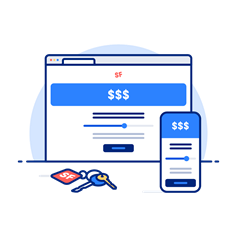What types of mortgages are there?
There are many different mortgage types - the two main types being fixed and variable. When considering your options, seek independent financial advice from a regulated mortgage advisor.
Within the variable category there can be variable rate mortgages, standard variable rate mortgages (SVR), tracker mortgages, discount mortgages, capped rate mortgages and offset mortgages. Basically a LOT of different types. But what’s the difference?
A fixed rate mortgage:
This means the interest you’re charged stays the same for a number of years, typically between two to five years. Your payments and interest will remain the same for the duration of the deal no matter what happens to interest rates at a country-wide or bank level.
You’ll see them advertised as ‘two-year fix’ or ‘five-year fix’, for example, along with the interest rate charged for that period.
Pros & Cons:
- A fixed rate will give you peace of mind that your monthly payments will stay the same, which will also help you to budget
- Fixed rate deals are usually slightly higher than variable rate mortgages
- If interest rates generally fall, you won’t see any benefit
- Remember: there may be charges if you want to leave the deal early – you are tied in for the length of the fix.
At the end of the fixed period – you should look for a new mortgage deal. It’s helpful to start this search two to three months before it ends or you’ll be moved automatically onto your lender’s standard variable rate which is usually higher.
Variable rate mortgages:
With variable rate mortgages, the interest rate can change at any time. If you have a variable mortgage, the rates may be lower to begin with, but can increase whenever. So you need to make sure you have sufficient savings set aside so that you can afford an increase in your payments if rates do rise.
Variable rate mortgages come in various forms:
Standard variable rate (SVR)
This is the normal interest rate your mortgage lender charges homebuyers and it will last as long as your mortgage or until you take out another mortgage deal. There is no standard rate, as -you guessed it - it varies.
Changes in the interest rate might occur after a rise or fall in the base rate set by the Bank of England.
Pros & Cons:
- Flexibility - you can choose to overpay or leave at any time
- Uncertainty - your rate can be changed at any time during the loan - and it could change significantly, which is something you always need to be prepared for
Discount mortgages
This is literally a discount off the lender’s standard variable rate (SVR). Usually these deals only apply for a certain length of time, typically two or three years. SVRs differ across lenders, so don’t get caught out by assuming a bigger discount will mean a lower overall rate.
What does that mean?
Imagine two banks have discount mortgage rates as follows:
- Bank A has a 3% discount off a SVR of 7% (which means the rate you’ll pay is 4%)
- Bank B has a 1% discount off a SVR of 4% (which means the rate you’ll pay is 3%)
Though the discount is larger for Bank A, Bank B would be the cheaper option.
Pros & Cons:
- Repayments - the rate starts off cheaper which means your mortgage will cost you less for a period
- If the standard variable rate (SVR) goes down, so would your payments
- Uncertainty – the lender is free to raise its SVR at any time, so your payments can fluctuate both ways
- If Bank of England base rates rise, you’ll probably see your rate increase too
- There will be charges if you want to leave before the end of the discount period
Tracker mortgages
Tracker mortgages are directly linked to another interest rate – normally the Bank of England’s base rate plus a few percent.
So if the Bank of England base rate goes up by 0.5%, your rate will go up by the same amount., every time.
Tracker mortgages are usually quite short term, usually between two and five years, however some lenders offer tracker mortgages which can be for the duration of your mortgage (or until you choose to remortgage!).
Pros & Cons:
- Payments can go up and down:
- If the rate it is tracking goes down, so will your mortgage payments
- If the rate it is tracking goes up, so will your mortgage payments
- Fees: there may be an early repayment charge if you want to switch before the deal ends
- Never say never: always double-check that your lender can’t increase the rate unless the rate your mortgage is linked to has moved. It’s not common, but it’s happened before and is worth reading the small print to check.
Capped rate mortgages
With this type of mortgage, the rate typically moves in line with the lender’s SVR. But the cap means the rate can’t rise above a certain level.
Pros & Cons:
- Certainty - you know your rate won’t rise above a certain level, which means you know what your max repayments could be each month.
- The cap tends to be set quite high so make sure you can afford the repayments if it rises to the top rate.
- Potential it could be cheaper - if the SVR rate falls, so will your rate.
- The rate is generally higher than other variable and fixed rates
- Your lender can change the rate whenever they want to, as long as it doesn’t go above the cap.
What mortgage is the right option for you is something only you can decide. You need to factor in how much you can afford, how you would cope if rates increased dramatically, and what options are available to you at the time you’re applying.
To find out what needs to be done to apply for a mortgage, read this
Sign up to our newsletter
Our newsletters bring you the latest articles to help you improve your financial wellbeing.
If you want to consent to receiving our newsletter please enter your email below to subscribe. If at any point you want to withdraw your consent please email hello@salaryfinance.com. For more information about how we use your personal data see our privacy notice.



